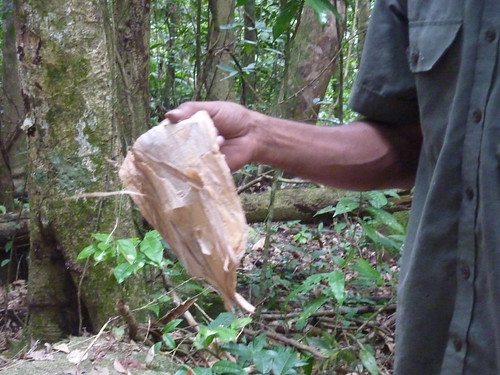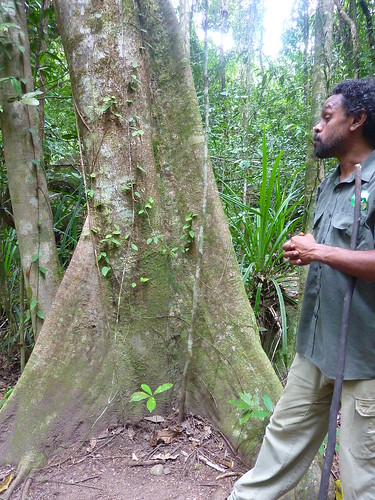

Robert also told us about boomerangs. A quintessential Australian icon, most people are only familiar with the returning boomerang - the arc-shaped variant. What we didn't realise is that there are several other types. X- and Y-shaped boomerangs are designed to take out a number of birds when thrown into a pack in the air, as they keep spinning. There are also hook-shaped boomerangs and one called a "killer" boomerang which is only used in the forest as it doesn't travel far but can easily knock out a wild pig or other similarly sized animal.

We were shown the candlenut tree, the fruit of which produces a lot of flammable oil and can work as a natural alternative to paraffin.


One nut's oil can produce as much as 20 minutes of flame; ideal for lighting a village and completely natural. The forest also provides other goodies (or not-so-goodies) - take for example this fallen tree which lay in our path:

Looking closely, you can see a black substance in the bark:

This is a tar tree, and the liquid oozing out of the trunk is very dangerous to touch. It will feel like your skin is on fire; the reason the branch hasn't been moved is that cutting it with a saw isn't possible - the amount of corrosive liquid that would come out of it when cut means unless you're wearing a hazmat suit, you would likely get burned by the stuff. As such, the only thing that the authorities can do is fence off any offending trees. It shows how ignorance in the forest can be dangerous - I'd never have considered tree sap to be so harmful. As with many things though, when used in certain ways it can be beneficial. Aborigines coat their spears and other weapons with it, and it acts like a poison which will stop the heart of any animal whose bloodstream it gets into. It also only affects the heart alone, so the meat itself is safe to eat.

Trees like the above provide shields and boomerangs for Aboriginal people. The process for creating one such shield can take many, many years; when the tree is small, they will drill a couple of holes into the bark and thread a handle through - maybe made from leaves or vines. Then, once the tree has grown sufficiently, they can cut out the shield complete with handle. Very clever. The angular trunk also makes it ideal for cutting out boomerangs. The "wait awhile" vine is used for fishing - it is covered in sharp thorns which will quickly entangle any passer-by who isn't paying attention in the forest:

It gets its name due to the length of time it takes to grow, as well the length of time it takes to unhook yourself if you're unfortunate enough to get tangled in it...
Robert took us next to a huge strangler fig in the heart of the forest:



This was the inspiration for James Cameron's treetop villages in Avatar. Robert told us that a number of the film crew came to take photographs of this tree and another close by when they were researching how the forest would look. It's an impressive sight, spreading its roots out in all directions and for amazing distances; Robert said that they had tracked the path of this particular tree's roots for over two kilometres. Strangler figs, as the name suggests, envelop an existing tree almost parasitically and grow downwards, essentially killing the host tree and turning it into a shell - this tree is actually two conjoined trees. These trees are sacred to the Aboriginal people and Robert told us the story of someone who didn't have a kind heart, who took photographs of the tree, but when he tried to develop them they all turned out blank. Robert said he could feel our warmth and kindness, and the tree was happy for us to be there. Which was nice.
We were taken to a cave in the forest to see some Aboriginal rock art which Robert couldn't date, but confirmed was at least a century old. Identifiable pictures included a dingo, stingray, cassowary and a ship - possibly Portuguese.



The colours were intriguing, and Robert showed us how these were made - simply by using different types of clay and mineral stones found in the area:


We were also shown the soap plant which produces a cleansing natural foam, that you can not only use to wash away dirt, but also treat various skin rashes and on top of which it works as an alternative to Deep Heat.
Other things we learned:
- Certain streams are used by Aborigines to bathe in, and also to give birth in. Women and men have separate bathing areas and streams and the tourist paths are closed if they ever want to use these. - The green ants which are found everywhere in this part of Australia can be eaten, and their pincers can be used as stitches.
- If a crime is committed within a tribe which warrants sufficient punishment, a tribe member can either choose to leave the tribe which would effectively exclude them from most other tribes, or opt to have a spear thrust through their leg. If the latter is picked, then the crime is forgiven and never spoken of again (but the recipient probably has a bit of a limp for the foreseeable future). If a man commits a crime against a woman, all of the women of the tribe form a "corridor" of two lines which the man has to walk through. Whilst walking, the women can hit him with sticks. If he runs, he has to go back to the start and do it again. If he survives to the end, his crime is forgiven - but many don't make it.
- Didgeridoos are made from branches hollowed out by termites. A branch is cut and placed on top of a termite mound, and the termites will eat their way up the centre of it.
On the subject of didgeridoos, Robert showed his skill at the end of the tour by giving us a demonstration. He said it took him about two weeks of solid practice; I guess he probably didn't have much else on during the time given how good he is; he managed to do impressions of animals and even a car, all fantastic.
I can highly recommend Kuku Yalanji Dreamtime Tours, it was a very enjoyable two hours spent with an inspirational man.

On the way back to Port Douglas we stopped off at Silky Oaks to jump off a stump into a freezing cold river. Well, why not? That night we cooked up a curry as a team effort, and I tried my hand at making scones using raw sugar and a measuring jug that used cups instead of ounces. They weren't a disaster but they turned out like cookies rather than scones.

They were a decent accompaniment to a game of Texas Hold'em Poker. After a strong start by Tom, I managed to pull back and win the game with a pair of queens on the flop, earning me the whopping sum of thirty bucks.

We hit the sack not long after, we were going to be up early the next day to dive the Great Barrier Reef with Erin as our guide.
No comments:
Post a Comment